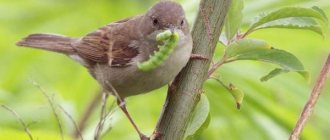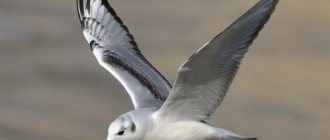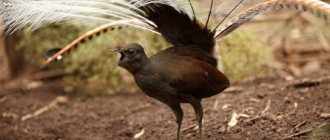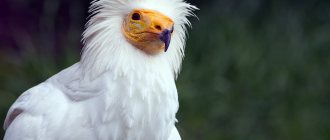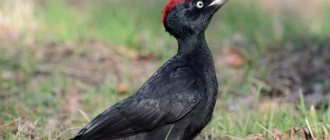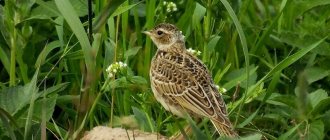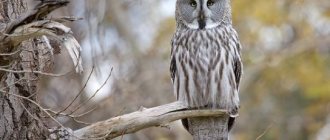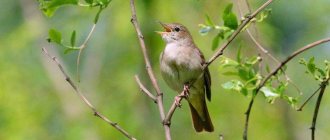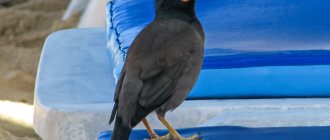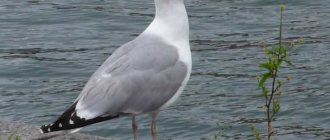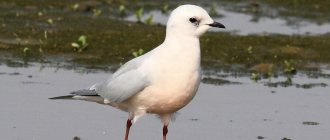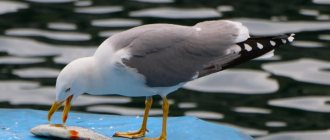The common river gull or black-headed gull (lat. сhroicocephalus ridibundus) is a representative of the gull family of the order Charadriiformes. The black-headed gull's habitat is the east coast of Canada and the Eurasian continent. Birds living in western Europe have a sedentary lifestyle, while others fly to the southern regions in winter. Birds living in Canada also move south for the winter.
For nesting, black-headed gulls choose ponds, floodplains, river deltas and lakes. They prefer shallow water with dense thickets of bushes and islands, often located on the seashore or choose calm bays and quiet bays for living, as they do not like constant open space. Birds usually prefer wide deltas and seashores of deep rivers, which are large in size.
The black-headed gull is a noisy bird . Her cry is creaky, similar to a rolling “kyarrr”, repeated several times, confirms active behavior. It is also characterized by “clucking”, “meowing” and sharp “keck” signals, reminiscent of human laughter.
In Russia, entire colonies of river gulls, the size of which can be several thousand, can be seen in freshwater bodies of water in the summer. Birds usually settle near food dumps and large cities.
Why don't seagulls fly south?
One of the main criteria for wintering gulls in their permanent habitats is the freezing of the water bodies near which they live. And since the Black Sea off the coast of Crimea does not freeze in winter, local seagulls have no need to fly away from here for the winter to warmer climes.
Interesting materials:
What does the name Safina mean? What does the name Seda mean in Arabic? What does the name Semyon mean for a boy? What does the name Severus Snape mean? What does Sim's name mean? What does the name Sophia mean? Wikipedia? What does the name Sofia mean in Arabic? What does the name Sofia mean? Wikipedia? What does the name Sonya mean in Greek? What does the name Styopa mean?
Diet
Next to predators, a small and at first glance cute bird turns into an aggressive and greedy hunter, entering into a battle for food with predators (bears, foxes, wolves). At the same time, seagulls try not to attack their opponents and never touch the offspring of other birds.
Common food for seagulls is small fish, squid, and leftover food from other animals.
Trying to get food for themselves and their chicks, seagulls can circle over the water for a long time, or fly several kilometers from the shore. Birds can usually be seen near whales and predatory fish, as they usually chase large schools of fish.
Birds can dive into the water for a short time, although they cannot hold their breath and stay there for a long time. During periods when fish move away from the shore, they do not disdain shellfish, crabs, the remains of various marine inhabitants, and, in extreme need, eggs of their feathered relatives.
Important! Arctic and steppe gulls feed on plants, mice, insects, and seasonal berries.
Now, thanks to their proximity to humans, the diet of birds has expanded significantly. They can often be seen in trash cans near beaches and in local landfills.
Reproduction
Immediately after returning “home” the mating season begins for the birds. Mating occurs only once a year. At the same time, seagulls are faithful lovers, trying to remain faithful to their partner all their lives. True, in the event of the loss of a female, her chosen one has to look for a new mate. To seal the union, the male brings a small fish in his beak and carefully places the catch next to his beloved.
Gulls' nests are located on ledges or in dense grass. Polar birds line their nests with algae and grass, while sea birds use shells, wood chips and leaves for this task. The female can lay no more than 3 eggs at a time and hatch them for 3-4 weeks.
The chicks do not appear immediately, but at intervals of several days. Immediately after birth, they see perfectly, although they are still unable to move. They stay in the nest for about 7 days, after which they go outside and meet their “relatives”.
Fact! If it is difficult to get food and there is little of it, the parents give all the catch to the largest or oldest chick, while the younger ones have to be sacrificed.
Sexual maturity is reached 2-3 years after birth, while life expectancy reaches 20 years.
INTERESTING FACTS, INFORMATION…
- Black-headed gulls have been nesting in Germany since at least 1633. In the documents of the Bavarian State Archives of that time, you can find a mention of a colony of these birds that nested in the Oberpfalz region, not far from the border with the Czech Republic. — In winter, the common gull is often found in many areas of Central Europe. However, this bird is difficult to distinguish from other species, since in winter its head is devoid of the characteristic dark brown hood.
- The gull is one of the few gull species that also nests inland.
- Having learned to fly, black-headed gull chicks immediately leave the nest.
Anatomy
Seagulls have a contrasting color (white underside and dark markings on the tips of the wings and head). Almost all the plumage of gulls is white, except for the head and wings, where there are dark spots. Gulls also have dark stripes on their backs that camouflage them. The color of the bird depends on what species the seagull belongs to. The average length of a bird is 30-80 cm, and its weight is most often from 150 g to 2 kg.
The birds have waterproof plumage, the wings are long and wide, and the tail is short. The beak of seagulls is straight, curved at the end to hold slippery fish. Seagulls have membranes on their feet that are very similar to flippers, which greatly helps them move through the water with great ease.
Migratory birds - introduction
These birds seem to live in two houses: their wintering place and nesting place are different and can be located at a considerable distance from each other. Migration often takes place in several stages, between which the birds take a break to rest. The list of such birds is quite extensive.
Birds begin to leave their permanent habitat at different periods: for example, orioles, nightingales, and swifts begin to set off at the end of summer, although the days are still warm and there is a real abundance of food for them. And waterfowl (swans, ducks) leave their reservoirs very late, waiting for the first frost.
Reasons for flying
Birds are most often heat-loving, their body is characterized by elevated temperature (often it exceeds 40°C). However, feathers protect them well from the cold, which is why they, of course, can live in the cold conditions of a harsh winter. But for this they need more food. And in the snowy season, food is not easy to come by! That is why birds have to leave their nests and fly to distant countries rich in food. As a rule, the inhabitants of the tundra and taiga are more susceptible to flights, where natural conditions are the most severe and food in winter is extremely scarce. A pattern has also been identified: insectivorous and carnivorous birds migrate most often, granivores migrate less often. The reason for this is obvious: grain can be found in winter, but even the sharpest beak cannot reach insects from under the snow. There are a large number of migrants among the inhabitants of the middle zone.
Types of seagulls with photos and names
The Gull family includes approximately six dozen species of birds. At the same time, young individuals are very different in appearance from adults. That is why the species characteristics of adult gulls will be discussed below.
Black-headed gull (Chroicocephalus ridibundus)
This bird is one of the most widespread species in nature. The entire body and back of the head of such an animal are white, only on the face there is a mark of a contrasting brown hue. It lives in the fresh waters of rivers and lakes. The weight of the bird varies from 0.25 to 0.35 kg, while its length can reach up to 0.4 m.
Black-headed gull - graceful bird, Black-headed gull
Little gull (Hydrocoloeus minutus)
Such birds differ from other species in that they are the smallest. As a rule, they weigh less than one hundred grams, and their length does not exceed 0.3 m. Such a seagull is completely white, except for the head, which is black.
Mediterranean gull (Larus michahellis)
A characteristic feature of this species are the irises, legs and beak, which are rich yellow in color. The wings of such an animal are pale gray, the head is white, and there are red circles around the eyes. Such a seagull naturally settles on the coast.
Relict gull (Ichthyaetus relictus)
This species is endangered. The white body of this animal is decorated with black markings, which appear only in the warm season. In winter, the entire body turns white. Its beak and legs have a rich red color. The bird reaches about 0.45 m in length.
Black-headed gull (Ichthyaetus ichthyaetus)
This relatively large bird reaches about 0.7 m in size, and its weight is about two kilograms. The body of such an animal is white, the wings are gray, and the head is black. At the end of the orange beak there is a black mark. The head is decorated with white spots located near the eyes at the bottom and top.
Sea pigeon (Chroicocephalus genei)
This half-meter gull has a gray back and wings, and a white head. Red paws and beak are distinguished by their elegance. There are dark black feathers in the wings and also in the tail.
Herring gull (Larus argentatus)
This incredibly beautiful bird has a very aggressive character. Its weight can reach 1.5 kg. The entire body is painted white, except for the black tail and gray wings. The beak, curved at the tip, is colored yellow, while the paws of this animal are pink.
Chough (Larus fuscus)
Such a large bird reaches a length of just over half a meter, and its average weight is about 0.8 kilograms. It is completely white, only the wings are painted gray. The beak is curved at the end. It, like its legs, is yellow in color. The head is decorated with red circles around the eyes.
Steppe Gull or Laughing Gull (Larus cachinnans)
Its size is about 0.65 m, and its average weight is up to 1.3 kilograms. Despite its impressive size, this bird looks very elegant in appearance. The legs and beak of this animal are yellow. But his body is white, except for gray wings. The tail is decorated with black feathers.
Sea gull (Larus marinus)
The main distinguishing feature of these birds is their very large size. They are larger than all other species. Their wings are a dark gray shade, and the rest of the plumage is white. The color of the beak is yellow, and the paws are light pink. The beak, curved at the end, has a speck of deep red color.
Black-tailed gull (Larus crassirostris)
In size it is similar to a blue gull: about 0.75 meters. Its body and head are white, and its tail is decorated with a clearly visible pitch-black stripe. The bird is also distinguished by its beak, at the end of which there are two markings: black and red.
Fork-tailed gull (Xema sabini)
An adult reaches a length of about 0.35 meters. A characteristic feature of this species is that during the mating season the bird's head becomes dark gray. And when this period ends, it again changes its color to white. This animal has gray wings and a white body, while the white tail is decorated with feathers of a deep black hue.
Ivory Gull (Pagophila eburnea)
This species is found in the Arctic. The bird's body is completely white and its greenish-yellow beak and black paws stand out brightly against its background.
Pink Gull - interesting facts
LIFESTYLE
Black-headed gulls are found in large numbers in the middle part of the Eurasian continent. They are distributed from Iceland and the British Isles in the west to the Pacific Ocean in the east. Common gulls spend the winter near the Mediterranean coast and on the African coast. Many black-headed gulls are found in Western Europe in winter. The flight occurs in September and often lasts until winter. River gulls have perfectly adapted to new living conditions. Today they are found far from the coast: in parks, rice fields, near artificial reservoirs and even on the streets of big cities. In flight, these birds are easily distinguished from other species by the black spots behind the eyes (in winter plumage) and the black tips of the wings. Seagulls usually live in flocks. At resting places - on islands, rocks, dams, fields or roofs of houses - large groups of these birds can be observed, often numbering up to several thousand individuals.
What do seagulls eat in the city?
The main source of food for seagulls is animal feed. Favorite delicacies include fish, crustaceans, and various invertebrates. A bird, in order to quickly extract juicy meat from a shell or crab, can throw it from a height onto stones.
Interesting materials:
What is True Cost? What is Tsem you? What is the price of the product? What is the price of the products? What is stroke and minute volume of the heart? What are vending machines? What is Vendor ID? What are the upper and lower planets? What is top rocker? What are extracurricular activities according to the Federal State Educational Standard?
